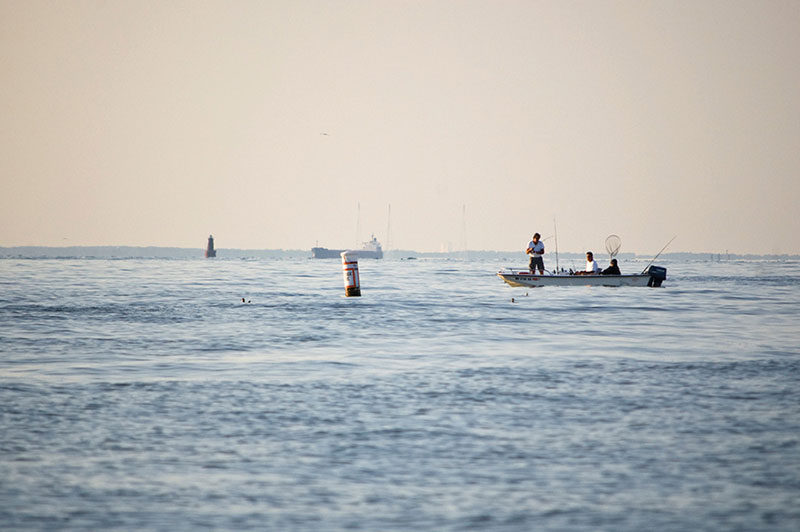By Timothy Wheeler
Bay Journal
A year after experiencing its best water quality in decades, the Chesapeake Bay is expected to have a larger than average “dead zone” this summer, where fish, crabs and shellfish will struggle to breathe.
Researchers with the University of Maryland Center for Environmental Science (UMCES) and the University of Michigan are forecasting that the volume of oxygen-starved water in the Bay will grow to 1.9 cubic miles, enough to nearly fill 3.2 million Olympic-sized swimming pools.
A “dead zone” is a popular term for water that’s low in oxygen, or hypoxic. Fish often leave such areas; if they’re trapped — or immobile, like shellfish — they can suffocate.
“The forecast is a reminder that the improvements such as we saw last year are subject to reversal depending on weather conditions—two steps forward, one step back,” said UMCES President Donald F. Boesch.
Last year, dissolved oxygen concentrations in the Bay mainstem and the tidal portions of its rivers were the best in three decades. Many areas maintained levels high enough to sustain fish and other aquatic life, and no place experienced “anoxic” conditions, with virtually no oxygen in the water. The diminished dead zone came on the heels of a robust rebound of Bay grasses and improved water clarity in much of the Chesapeake.
Rains flush nitrogen down Susquehana
But last year’s good conditions stemmed in part from below-average rainfall. This spring, scientists say, heavy rains fell in Pennsylvania and New York, which flushed an above-average amount of nitrogen down the Susquehanna River.
Scientists expect an above-average volume of low-oxygen water, while the smaller anoxic zone of water with virtually no oxygen is expected to be average in size early in summer – 0.35 cubic miles – then grow to slightly above-average by late summer at 0.49 cubic miles.
“Although the higher forecasts for this summer seem to buck a recent trend toward lower anoxic volumes in Chesapeake Bay, they are consistent with known links between high river flows and oxygen depletion,” said Jeremy Testa, assistant professor at the UMCES Chesapeake Biological Laboratory.
The Bay’s chief water-quality problem stems from nutrient pollution. Massive algae blooms are fed by excessive amounts of nitrogen and phosphorus from farm and urban runoff and from sewage treatment plants, among other sources.
The algae then die and sink to the bottom, where their decomposition consumes oxygen in the water. Typically, a large area of “hypoxic” or low oxygen water forms each summer, stressing fish and shellfish, while a smaller area experiences “anoxic” conditions, where levels drop close to zero.
This spring’s heavy rains in Pennsylvania and New York delivered 81.4 million pounds of nitrogen to the Bay via the Susquehanna, a little more than the long-term average. The “dead zone” forecast is based on mathematical models developed with funding from the National Oceanic and Atmospheric Administration and it relies on nutrient estimates provided by the U.S. Geological Survey.
Bay water trending better
Scientists say that notwithstanding the return this summer of a worse-than-average dead zone, the Bay’s water quality does appear to be trending better overall.
“Despite this year’s forecast, we’ve made great strides in reducing nutrient pollution from various sources entering the Chesapeake Bay, and we are starting to see positive long-term signs,” said Rob Magnien, director of NOAA’s Center for Sponsored Coastal Ocean Research. “However, more work needs to be done to address non-point nutrient pollution from farms and other developed lands, to make the Bay cleaner for its communities and economic interests.”
The Trump administration has proposed eliminating federal funding next year for the Environmental Protection Agency’s Chesapeake Bay Program office, and deep cuts in other federal programs that contribute to the restoration effort.
Boesch said the forecast shows why the federal government can’t let up on the Bay restoration effort, which began in 1983. After slow progress and repeatedly missed cleanup deadlines, the EPA imposed a “pollution diet” in 2010. The six states in the Chesapeake watershed and the District of Columbia have until 2025 to take all the steps needed to reduce nutrients and maintain good oxygen levels year-round.
“This underscores the critical importance of continued investments by federal agencies in science and monitoring as the states continue to implement the Bay’s pollution diet,” Boesch said.
Tim Wheeler is managing editor of Bay Journal, published by Bay Journal Media, a 501(c)(3) nonprofit, to inform the public about issues that affect the Chesapeake Bay. A print edition is published monthly and is distributed free of charge. News, features and commentary are available free online at bayjournal.com. MarylandReporter.com is partnering with the Bay Journal by publishing one of its stories every Friday.




Recent Comments